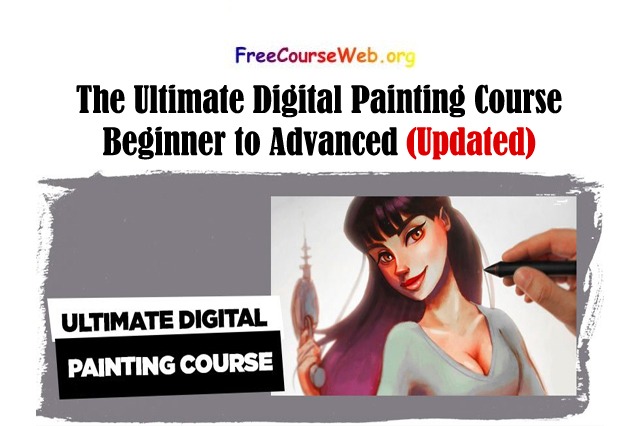The Ultimate Digital Painting Course Welcome to the Ultimate Digital Painting Course!
In this course, you will learn everything you need to know about digital painting, from the very basics to advanced techniques.

The Ultimate Digital Painting Course Whether you are a complete beginner or an experienced artist, this course will provide you with the knowledge and skills you need to create stunning digital paintings.
Ultimate Digital Painting Course
Web Development Bootcamp with 85% Discount
Best Udemy Courses in 2023 with 85% off
Here’s a breakdown of what you’ll learn in this course:
Module 1: Getting Started In this module, we’ll cover the basics of digital painting, including the tools and software you need to get started.
1.1 Introduction to Digital Painting
- What is digital painting?
- Benefits of digital printing over traditional painting
- Popular software and tools for digital painting
- The Ultimate Digital Painting Course
1.2 Choosing the right hardware and software
- Types of hardware (tablets, monitors, etc.) and software (Photoshop, Procreate, etc.) available
- Factors to consider when choosing hardware and software
- Recommended hardware and software for beginners
1.3 Setting up your workspace
- Organizing your files and folders
- Customizing your digital painting software workspace
- Setting up your tablet and stylus
1.4 Understanding digital brushes and their settings
- Types of brushes available and their uses
- Adjusting brush settings for different effects
- Creating custom brushes
Module 2: Basic Techniques In this module, we’ll cover the fundamental techniques used in digital painting, including color theory, creating basic shapes and forms, applying lighting and shadow, and adding texture and detail.
2.1 Understanding Color Theory
- The color wheel and color relationships
- Using color to create mood and atmosphere
- Choosing and creating color palettes
2.2 Creating basic shapes and forms
- Sketching and blocking in shapes
- Creating depth and dimension with shading
- Creating 3D objects with perspective
2.3 Applying lighting and shadow
- Understanding light sources and their effects
- Creating highlights and shadows
- Painting realistic lighting and shadow on objects
2.4 Adding texture and detail
- Using brushes to create texture
- Applying texture to different surfaces
- Adding details to bring your painting to life
Module 3: Intermediate Techniques In this module, we’ll build on the basic techniques covered in Module 2 and explore more advanced techniques, including creating complex compositions, mastering perspective, painting realistic portraits, and developing your own style.
3.1 Creating Complex Compositions
- Planning and sketching your composition
- Using color and lighting to create depth and focus
- Balancing your composition for a pleasing result
3.2 Mastering perspective
- Understanding vanishing points and horizon lines
- Using perspective to create depth and realism
- Painting environments with multiple points of perspective
3.3 Painting realistic portraits
- Understanding facial anatomy and proportions
- Painting realistic skin tones and textures
- Adding details like hair and accessories
3.4 Developing your style
- Finding inspiration and developing a personal style
- Experimenting with different techniques and effects
- Creating a consistent body of work
Module 4: Advanced Techniques In this final module, we’ll explore advanced techniques for digital painting, including creating dynamic scenes and environments, painting with light and color, adding special effects and finishing touches, and tips and tricks for speeding up your workflow.
4.1 Creating dynamic scenes and environments
- Designing environments and backgrounds
- Using lighting and color to create mood and atmosphere
- Adding details like weather and textures
4.2 Painting with light and color
- Understanding color theory in more depth
- Using lighting and color to create drama and emotion
- Creating effects like fire and water
- The Ultimate Digital Painting Course
4.3 Adding special effects and finishing touches
- Adding special effects like glows and lens flares
- Applying filters and adjustments for a polished look
- Adding final details like signature and watermark
4.4 Tips and tricks for speeding up your workflow
- Using keyboard shortcuts to speed up your process
- Creating and using custom brushes
- Setting up actions and automation to streamline your workflow
you will need the following requirements:
- A computer or tablet with digital painting software installed, such as Adobe Photoshop or Procreate.
- A digital pen tablet or display to use with your digital painting software.
- A stable internet connection to access the course materials and videos.
- Basic knowledge of using a computer and navigating through software applications.
- A willingness to learn and practice digital painting techniques.
- The Ultimate Digital Painting Course
In this course, you will learn the following:
- The basics of digital painting, including the tools and software needed to get started.
- Choosing the right hardware and software for digital painting.
- Setting up your workspace and understanding digital brushes and their settings.
- Fundamental techniques used in digital painting, such as color theory, creating basic shapes and forms, applying lighting and shadow, and adding texture and detail.
- Advanced techniques for digital painting, including creating complex compositions, mastering perspective, painting realistic portraits, and developing your own style.
- Creating dynamic scenes and environments, painting with light and color, adding special effects and finishing touches, and tips and tricks for speeding up your workflow.
- Throughout the course, you will also have the opportunity to practice your skills through various exercises and assignments.
How to Build a Successful Affiliate




